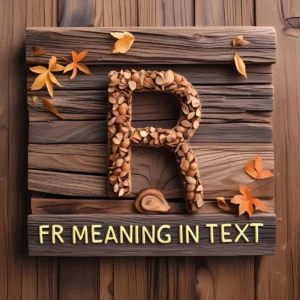Have you ever noticed PS at the end of a text or email and wondered what it stands for? 🤔 This tiny acronym is a staple in digital and written communication, popping up in texts, social media, and even professional messages. Whether it’s a friend adding an afterthought or a colleague sharing an extra note, PS adds a personal touch to conversations.
Understanding its meaning helps you follow messages clearly and respond with confidence. From casual chats to formal emails, PS is a versatile tool. In this guide, we’ll explore what PS means, its history, and how to use it effectively. Let’s jump in and decode PS! 🚀
Definition & Meaning
PS stands for Postscript in texting and writing. It’s used to add an extra thought or piece of information after the main message.
Key Points:
- Postscript comes from Latin, meaning “written after.”
- It’s often used to highlight something forgotten or to emphasize a point.
- In texting, PS adds a casual or thoughtful note to a message.
Examples:
- Texting:
- Friend 1: “I’ll meet you at 6 for dinner. Bring your jacket! PS: Can you grab some dessert? 🍰”
- Friend 2: “Got it! I’ll bring cupcakes! 😋”
- Email:
- Sender: “Here’s the report you requested. Please review by tomorrow. PS: Let me know if you need the data in a different format.”
- Recipient: “Thanks, I’ll check it out!”
PS is a quick way to add something extra without rewriting the message.
Background & History
The term PS has a rich history:
- Origin: PS comes from the Latin post scriptum, meaning “written after.” It began in handwritten letters centuries ago, when writers added extra notes after signing off.
- Evolution: With typewriters and early computers, PS remained a way to include afterthoughts. It became common in emails and texts as digital communication grew in the 1990s.
- Modern Use: Today, PS is used in both casual and formal settings to add notes, reminders, or personal touches.
Key Points:
- PS started in handwritten letters 📜.
- It became a texting and email staple in the digital age 💻.
- Now, PS is recognized globally as a way to add extra info.
Usage in Various Contexts
PS is flexible and appears in many settings:
- Texting 📲:
- Adds a casual afterthought or reminder.
- Example:
- Friend: “I’m heading to the mall later. Want to join? PS: They have a sale! 🛍️”
- You: “Count me in! Thanks for the heads-up! 😊”
- Social Media 🐦:
- Used in captions or comments for extra thoughts.
- Example:
- Post: “Loved the concert tonight! Amazing vibes! 🎶 PS: Check my story for videos! 📸”
- Reply: “Looked so fun! I’ll watch now! 😄”
- Gaming 🎮:
- Less common, but may appear in chats for extra notes.
- Example:
- Gamer 1: “Join my team at 8! We’re playing ranked. PS: Bring your best gear! ⚔️”
- Gamer 2: “I’m ready! Thanks for the tip! 😎”
- Casual Conversations 🗣️:
- Used in written notes or informal emails.
- Example:
- Note: “Thanks for the invite! I’ll be there. PS: Can I bring a friend? 🎉”
- Response: “Of course, the more the merrier! 😊”
Key Point: PS adds a personal or practical note in any written context. ✍️
Common Misconceptions & Clarifications
PS is straightforward, but some misunderstandings exist:
- Misconception: PS is only for formal letters.
- Clarification: It’s used in casual texts, emails, and social media too.
- Misconception: PS is outdated in digital communication.
- Clarification: It’s still popular for adding quick notes or emphasis.
- Misconception: PS can be used multiple times (e.g., PPS, PPPS).
- Clarification: While technically possible, multiple PSs can seem cluttered or confusing in texts.
Key Point: Use PS sparingly to keep messages clear and friendly. 😊 For example, adding “PS: Don’t forget!” is fine, but avoid “PPS” in casual texts.
Similar Terms & Alternatives
Here are alternatives to PS:
- By the way (BTW)
- Also
- One more thing
- Note
Comparison Table:
| Term | Meaning | Best Used In |
|---|---|---|
| PS (Postscript) | Extra note after the message | Texts, emails, letters |
| By The Way (BTW) | Casual addition or side note | Informal chats, social media |
| Also | Adds related information | Formal or neutral settings |
| Note | Highlights a point | Professional or written notes |
Key Point: Choose alternatives like “BTW” for casual chats or “Note” for formal settings to keep things clear. ✅
How to Respond to This Term
Your response to PS depends on the tone:
- Casual 😊:
- Example:
- Friend: “Meet me at 7 for coffee! PS: Bring your book! 📚”
- You: “Can’t wait! Got the book! 😄”
- Example:
- Humorous 😂:
- Example:
- Friend: “Party at my place! PS: Bring snacks! 🍕”
- You: “Snacks incoming, but don’t blame me if they’re gone fast! 😜”
- Example:
- Professional 💼:
- Example:
- Colleague: “Here’s the schedule. PS: Can you confirm the time?”
- You: “Thanks, I’ll confirm by noon.”
- Example:
- Neutral 🔒:
- Example:
- Friend: “I’m free this weekend. PS: Let me know if you’re around! 🗓️”
- You: “Cool, I’ll let you know! 😊”
- Example:
Key Point: Respond to the PS directly to show you noticed the extra note. 🧠
Regional or Cultural Differences
PS is widely used, with minor variations:
- Western Countries 🌎: PS is common in texts, emails, and letters for adding afterthoughts.
- Asia 🇯🇵: Used similarly, especially in professional emails or casual texts, though less frequent in some languages due to different writing styles.
- Other Regions 🌍: PS is recognized globally, thanks to its use in English-based communication, but may be less common in non-Latin scripts.
Key Point: PS is universal but more common in English-speaking or digital-heavy regions. 🌐
Comparison with Similar Terms
Here’s how PS compares to similar terms:
| Term | Meaning | Key Difference |
|---|---|---|
| PS (Postscript) | Extra note after the message | Specific to written communication |
| By The Way (BTW) | Casual side note | More conversational, less structured |
| Also | Adds related information | Neutral, fits formal contexts |
| One More Thing | Highlights an afterthought | Informal, less common in texts |
Key Point: PS stands out for its formal roots but works in casual settings too. ✨
Usage in Online Communities & Dating Apps
PS is common online:
- Twitter/X 🐦: Used in posts or comments for extra thoughts.
- Example:
- Post: “Loved the new movie! Great plot! 🎬 PS: The soundtrack is amazing! 🎵”
- Reply: “Totally agree! I’ll check the soundtrack! 😄”
- Example:
- Dating Apps 💘: Adds a playful or thoughtful note in profiles or messages.
- Example:
- Bio: “Love hiking and coffee. PS: Bonus points if you like dogs! 🐶”
- Message: “Dog lover here! What’s your favorite hike? 😊”
- Example:
- Gaming Communities 🎮: Rare, but used in chats for extra notes.
- Example:
- Discord: “Join my squad at 9! PS: We need a healer! 🛡️”
- Reply: “I’m in! I’ll play healer! 😎”
- Example:
Tips:
- On dating apps, respond to the PS to show interest and keep the chat going.
- In gaming, acknowledge the PS to confirm you saw the extra note. 🚀
Hidden or Offensive Meanings
PS is safe and neutral:
- No Offensive Meanings ✅: Postscript is harmless and widely accepted.
- Potential Issue: Overusing PS (e.g., multiple PSs) can seem disorganized or unprofessional.
- Context Matters: In formal settings, too many PS notes might confuse readers.
Key Point: Keep PS simple and relevant to avoid cluttering your message. 😊
Suitability for Professional Communication
PS can work in professional settings but with caution:
- Postscript 📝: Acceptable in emails for brief, relevant afterthoughts, but avoid overusing it.
- Casual Tone: In texts or informal emails, PS adds a friendly touch, but it may seem out of place in very formal reports.
Alternatives:
- Instead of “PS: Please confirm,” say “Please confirm” in the main text.
- Instead of “PS: I’ll call later,” include it in the email body for clarity.
Key Point: Use PS sparingly in professional settings to maintain clarity and professionalism. 💼
FAQs
- What does PS mean in texting? 🤔
- It means “Postscript,” an extra note added after the main message.
- When should I use PS? 🧐
- Use it for afterthoughts or reminders in texts, emails, or posts.
- Is PS okay for professional emails? 📧
- Yes, for brief notes, but keep it minimal and relevant.
- Can PS be offensive? 😳
- No, it’s neutral and safe in all contexts.
- How should I reply to a PS in a text? 💬
- Address the PS directly, like “Thanks for the note!” or “Got it!”
- Is PS used differently around the world? 🌍
- It’s similar globally but more common in English-speaking or digital communication.
- Does PS appear on dating apps? 💕
- Yes, often for fun or thoughtful notes. Respond to it to keep the conversation flowing.
Conclusion
PS is a timeless acronym meaning Postscript, perfect for adding extra thoughts to texts, emails, or posts. Whether you’re reminding a friend about a meetup or adding a note to an email, PS keeps communication lively and personal. This guide covered its meaning, history, and usage across texting, social media, and more. We also shared tips to respond smoothly and avoid confusion. With PS, you can enhance your messages and connect effortlessly. Next time you see PS, you’ll know it’s a thoughtful afterthought ready to spark a reply! 🌟✍️


